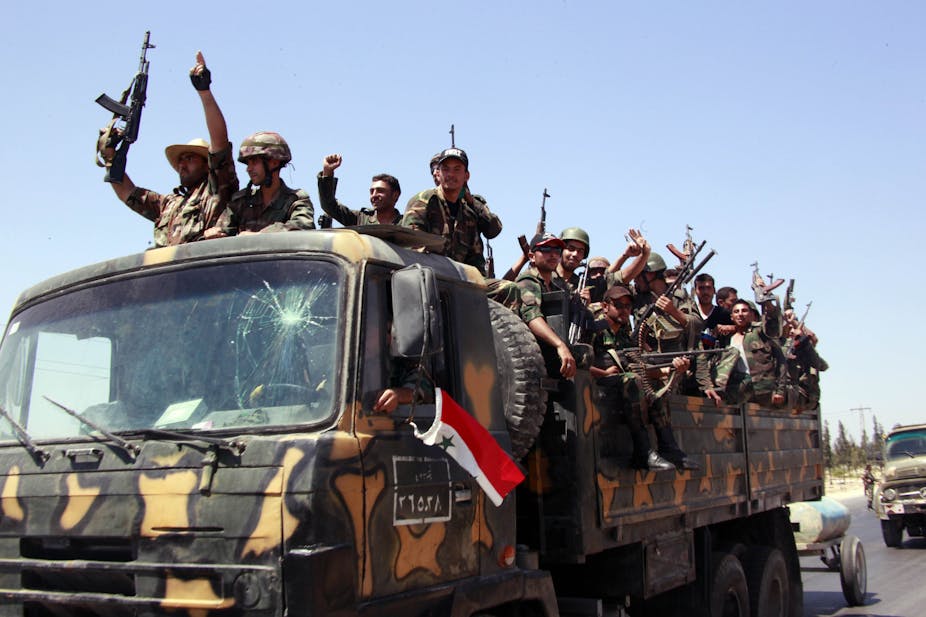The United States has stepped up sanctions against Syria, targeting President Bashar al-Assad’s financial resources. Syria claims to have withdrawn its troops from the city of Hama, which has played a central role in the uprising against the President’s rule. More than 1700 people have died, and thousands arrested in the country since March.
Government forces have been heavily engaged in the suppression of unrest across the country, and this phase of the struggle has particular significance for both sides
In 1982, the government of Hafez Al Assad was shaken to its foundations by an insurrection led by the Syrian branch of the Muslim Brotherhood, centred in Hama. Senior members of the regime were murdered and there was widespread unrest across the country.
In response, the President resolved that it was more important to be feared than to be loved. He turned his forces loose on Hama, with the loss of tens of thousands of people and the destruction of much of the heart of the city.
The response of both sides to the latest unrest appears to be coloured by that memory and the struggle has assumed almost existentialist dimensions. Neither side seems to be able to contemplate concessions to the other.
Assad still in control
President Bashar Al Assad still seems to enjoy the support of the armed forces and security services as well as his Alawite community. He probably has the support of business elites in Damascus and Aleppo, the country’s second city. These cities are largely Sunni Muslim, like Hama, but they tend to be suspicious of their more conservative co-religionists. As long as this alliance holds together the regime should be secure.
The question is where will this turmoil lead? There seems to be no domestic means to break the deadlock. Assad appears unable to stop the unrest. He has lost the affection of his population but does not seem to be feared in the way his father was.
No sooner is one region of the country brought under control than unrest breaks out somewhere else, placing increasing strain on the security forces.
Despite the emergence of local coordinating committees, the opposition has no apparent leadership and its objectives are still developing.
Who can help end the violence?
This leaves the United Nations and Syria’s neighbours as potentially the only means by which an end to the violence might be achieved.
The United Nations Security Council turned its attention to the issue but Council is divided over what it can and should do.
The Americans have imposed sanctions against members of the regime and have called on Assad to step down. The Europeans have also imposed sanctions but cannot agree on further steps.
No one, including the Americans and the Israelis, seems to want far-reaching regime change, being concerned about the instability that might result in such a volatile part of the region.
For all its faults, the Syrian government has ensured a long period of relative calm along Israel’s northern borders.
The UN’s role
Moreover, there does not appear to be much appetite in the West for yet another military adventure in the region.
Russia, China and some of the non-permanent members of the Council, such as Brazil, India and South Africa, have made it clear that they do not trust the West to abide by the rules of any Security Council resolution.
They point out that resolutions dealing with Libya have been imaginatively interpreted by the West to include regime change. The result of such uncertainty is the Security Council President’s statement of 3rd August, the weakest step the Council can take and a sign to Assad that he need not fear international action at this stage.
Syria’s neighbours
This leaves us with Syria’s neighbours, in particular, Saudi Arabia, Turkey and Iran. These countries are deeply interested in Syria’s future, in part because it is becoming a focus for the emerging regional rivalry between them.
Saudi Arabia is instinctively opposed to the aspirations of the people of Syria but has decided it needs to try to put a stop to the violence. The Saudis have withdrawn their ambassador from Damascus, an action dutifully followed by other Gulf states.
Iran has made some derisory calls on the Syrians to respect the demands of its people - demands which Iran denies its own population, but has also interpreted the unrest in Syria as potentially emboldening its own opposition, the Green Revolution.
Turkey, which has been expanding its interests in Syria and is concerned about that country’s Kurdish population and the flow of refugees across its border, has attempted to act as an honest broker. Turkey’s efforts have, however, been rebuffed by Assad.
Where does the solution lie?
Perhaps, as US Secretary of State Clinton suggested, the solution must come from within Syria.
It is possible the protesters will run out of steam in the face of unremitting government repression.
Alternatively, the ongoing death and destruction might lead to pressure among the regime’s domestic allies for an end to the violence.
Such a development might compel the government to make concessions sufficient to take the momentum out of the protest movement. The recent replacement of the Minister of Defence could be a sign of movement in that direction.

